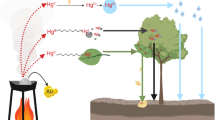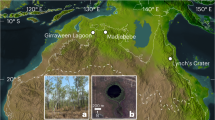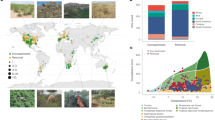Abstract
Mean sulphur dioxide levels have fallen markedly in London, UK during the past 15 yr. Although lichens growing on trees are particularly sensitive to this air pollutant, there are few studies of lichen recolonization following pollution episodes. A survey of 29 sites in the north and west of Greater London, reported here, demonstrates that several species extinct or very rare in the area in 1970 have extended their ranges considerably. Studies on growth rates of the species concerned suggest that many of the sites discovered have been recolonized within the past 3–7 yr. If current trends continue, further improvements in the lichen flora can be expected in the next few years. However, it is unlikely that London will regain in the forseeable future many of the species lost during the past two centuries.
This is a preview of subscription content, access via your institution
Access options
Subscribe to this journal
Receive 51 print issues and online access
$199.00 per year
only $3.90 per issue
Buy this article
- Purchase on Springer Link
- Instant access to full article PDF
Prices may be subject to local taxes which are calculated during checkout
Similar content being viewed by others
References
The United Kingdom Environment 1979: Progress of Pollution Control, Pollut. Pap. no. 16 (HMSO, London, 1979).
Sanford, H. Lond. Nat. 58, 89–92 (1979).
Hawksworth, D. L. & Rose, F. Nature 227, 145–148 (1970).
Ferry, B. W., Baddeley, M. S. & Hawksworth, D. L. (eds) Air Pollution and Lichens (Athlone Press of the University of London, London, 1973).
Hawksworth, D. L. Lichenologist 6, 122–125 (1974); 7, 62–66, 173–177 (1975); 8, 87–91, 179–182 (1976); 9, 77–82, 147–151 (1977); 10, 95–100 (1978).
Hawksworth, D. L. & Henderson, A. Lichenologist 10, 227–230 (1978); Henderson, A. & Hawksworth, D. L. Lichenologist 11, 91–95 (1979).
Henderson, A. Lichenologist 11, 313–319 (1979); 12, 145–148, 397–402 (1980).
Hawksworth, D. L. & Rose, F. Lichens as Pollution Monitors, Stud. Biol. no. 66 (Arnold, London, 1976).
Jürging, P. Biblthca lich., Lehre 4, 1–164 (1975).
Skye, E. & Hallberg, I. Oikos 20, 547–552 (1969).
Westman, L. Wahlenbergia 2, 1–146 (1975).
Lindsay, D. C. Proc. Bgham nat. Hist. Soc. 23, 234–249 (1978).
Seaward, M. R. D. Proc. Leeds lit. phil. Soc., Sci. 10, 141–208 (1976).
Henderson, A. Naturalist, Hull 1977, 141–144 (1977).
Henderson-Sellars, A. & Seaward, M. R. D. Environ. Pollut. 19, 207–213 (1979).
Gilbert, O. L. Lichenologist 12, 325–395 (1980).
Hawksworth, D. L. Lichenologist 4, 105–193 (1969).
Laundon, J. R. Lond. Nat. 49, 20–69 (1970).
Bailey, R. H. & James, P. W. Lichenologist 11, 105–106 (1979).
Hawksworth, D. L. & Rose, C. I. J. Ruislip Distr. nat. Hist. Soc. 22, 23–29 (1979).
Topham, P. B. in Lichen Ecology (ed. Seaward, M. R. D.) 31–68 (Academic, London, 1977).
Gilbert, O. L. Lichenologist 5, 11–17 (1971).
Seaward, M. R. D. in Lichenology: Progress and Problems (eds Brown, D. H., Hawksworth, D. L. & Bailey, R. H.) 323–357 (Academic, London, 1976).
Armstrong, R. A. thesis, Univ. Oxford (1974).
Hawksworth, D. L., Rose, F. & Coppins, B. J. in Air Pollution and Lichens (eds Ferry, B. W., Baddeley, M. S. & Hawksworth, D. L.) 330–367 (Athlone Press of the University of London, London, 1973).
Hawksworth, D. L. in Air Pollution and Lichens (eds Ferry, B. W., Baddeley, M. S. & Hawksworth, D. L.) 38–76 (Athlone Press of the University of London, London, 1973).
Brown, D. H. & Smirnoff, N. Lichenologist 10, 91–94 (1978).
Nash, T. & Sigal, L. Bryologist 82, 280–285 (1979).
Nash, T. Bryologist 79, 103–106 (1976).
Arvidsson, L. Svensk hot. Tidskr. 72, 285–292 (1979).
Brentford & Chiswick Times, 11 January (1980).
Gilbert, J. L. Bull. Br. Lichen Soc. 46, 7 (1980).
Hawksworth, D. L. & Seaward, M. R. D. Lichenology in the British Isles 1568-1975 (Richmond Publishing, Richmond, 1977).
Laundon, J. R. Lichenologist 3, 277–327 (1967).
Ferry, B. W. & Coppins, B. J. Lichenologist 11, 63–77 (1979).
Warren Spring Laboratory The Investigation of Air Pollution. National Survey. Smoke and Sulphur Dioxide (Department of Trade and Industry, Stevenage, 1962–80).
Author information
Authors and Affiliations
Rights and permissions
About this article
Cite this article
Rose, C., Hawksworth, D. Lichen recolonization in London's cleaner air. Nature 289, 289–292 (1981). https://doi.org/10.1038/289289a0
Received:
Accepted:
Issue Date:
DOI: https://doi.org/10.1038/289289a0
This article is cited by
-
A data-driven evaluation of lichen climate change indicators in Central Europe
Biodiversity and Conservation (2020)
-
Modelling local uncertainty in relations between birth weight and air quality within an urban area: combining geographically weighted regression with geostatistical simulation
Environmental Science and Pollution Research (2018)
-
Lichen recolonisation in an urban-industrial area of southern Poland as a result of air quality improvement
Environmental Monitoring and Assessment (2011)
-
Comparison of rRNA genotype frequencies ofParmelia sulcata from long established and recolonizing sites following sulphur dioxide amelioration
Plant Systematics and Evolution (1999)
-
The biological indication of SO2
Experientia (1986)
Comments
By submitting a comment you agree to abide by our Terms and Community Guidelines. If you find something abusive or that does not comply with our terms or guidelines please flag it as inappropriate.



